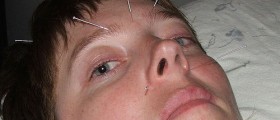
Bell's palsy is a neurological condition that develops once the 7th cranial nerve, the facial nerve, is compressed or damaged. The 7th cranial nerve travels from the brain and goes through a narrow, bony canal in the skull. In case this part of the facial nerve becomes edematous for any reason, it is easily damaged because bony canal cannot expand.
Humans have two facial nerves, each innervating one side of the face. The nerve innervates the muscles of facial expression, the anterior two-thirds of the tongue and oral cavity as well as lacrimal glands, salivary glands and a muscle in the middle ear.
In case of Bell's palsy there is clearly interruption of transmission of signals from the brain to the parts of the head innervated by the nerve.
Bell's Palsy Clinical Characteristics
Symptoms of Bell's palsy may vary from mild to rather severe but they are practically the same in all affected individuals. Muscles innervated by the facial nerve become weak. This is the reason why patients are unable to frown, to close their eyes and smile while at the same time showing their teeth. Drooping eyelid is responsible for vision problems, while drooling may be quite embarrassing. Since the eye cannot be completely shut, it soon becomes dry and is prone to infections, corneal erosions and other complications. Excess tearing of the eye is one more characteristic of the disease.
Most symptoms and signs of Bell's palsy develop suddenly and within 48 hours become the most intensive.
Additional, but not so common complaints such patients may have are pain/discomfort around the jaw and behind the ear, ringing in one/both ears, loss of taste, hypersensitivity to sound and dizziness.
Causes of Bell's Palsy
The actual cause of nerve irritation and subsequent inflammation and damage has not been identified yet. However, experts believe that Bell's palsy may be associated with some viral infections (herpes simplex, influenza etc.). Chronic middle ear infections, hypertension, diabetes, sarcoidosis, Lyme disease and trauma of the head are several more potential reasons behind Bell's palsy. Finally, any tumor compressing the facial nerve eventually triggers the previously mentioned symptoms.
Diagnosis and Treatment for Bell's Palsy
It is sufficient enough to examine patients and establish the diagnosis. However, doctors perform further tests and exams in order to identify the underlying cause. By performing a neurological exam doctors can be sure what parts of the face are affected and to differentiate central from peripheral facial nerve palsy. Additional help is obtained from EMG (electromyography). MRI or CT scan of the head may confirm or rule out the presence of tumors compressing the nerve.
In some patients symptoms gradually subside and eventually go away. If condition is confirmed to be connected with some infection, by treating the infection Bell's palsy will be brought under control. Most patients will be administered steroids such as Prednisone. This drug reduces inflammation of the swollen nerve.
Integral part of treatment is eye protection. The affected eye is exposed to irritation, becomes dry and requires special care. It is supposed to be kept moist and clean. Regular application of artificial tears and specific ointments is a must. Eye patches are worn at night.
Weak muscles may restore their strength with physical therapy. And finally, patients who have not fully restored function of the affected muscles may undergo cosmetic or reconstructive surgery.

















Your thoughts on this
Loading...